Host Explained: How it was Made, Easter Eggs and all Your Questions Answered
Shudder’s lockdown horror, Host, is fast becoming the defining movie of 2020 - director Rob Savage breaks it down
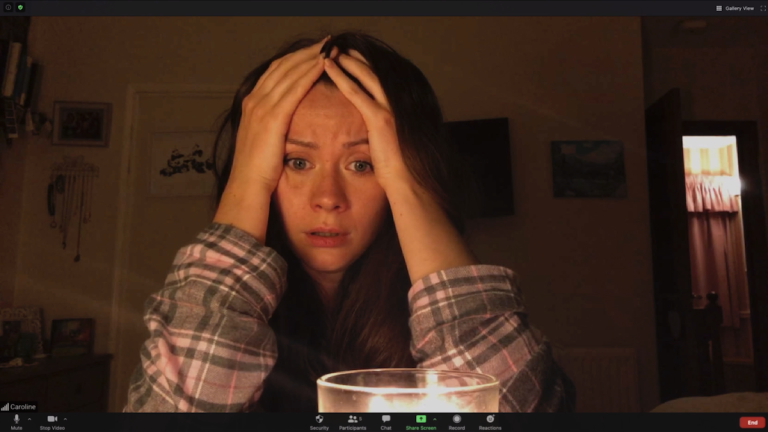
Massive spoilers for Shudder original HOST to follow.
Productions are shut down, movie theatres are barely open, we’re fast running out of new things to watch. Then Rob Savage and his talented team of mates make Host in 12 weeks and all bets are off.
This is the new horror phenomenon from Shudder, a film based entirely around a Zoom call where a group of friends do an online seance and accidentally invite something terrifying into their houses. It runs at a brief 56 minutes but manages to pack that runtime with character development, humour and proper pee-your-pants scares. And don’t just expect creepy things in the background – by the final act, which Savage refers to as “the freak out”, the movie employs full on stunt work, prosthetics and major shocks, all of which were done socially distanced. It really is an extraordinary piece of work which has unsurprisingly taken horror audiences by storm.
It’s also a film full of hints, easter eggs, references and ambiguities. We sat with Savage – via Zoom, of course – for an incredibly spoilery breakdown of Host and how it was made.
It’s been over a week now since Host was released – how has this time been? It must be weird launching your film on lockdown?
Rob Savage: It’s really weird. And it’s really weird because I made the movie basically sitting around in my flat, in my dressing gown. And we released the movie with me sitting around in my flat and in my dressing gown. And the response has happened with me… sat in my dressing gown. So it doesn’t quite feel real. I know everyone says that, but because there hasn’t been a premiere, there hasn’t been some sort of big launch where you can see 100 faces smiling back at you, it kind of just feels like I’m basically just sitting on my laptop like everyone has been for the past six months. So there’s a weird disconnect to the whole thing, but it’s obviously lovely. It’s amazing. It’s amazing that it exploded beyond just the horror community because we made it for horror fans. We wanted to get it out on Shudder and we wanted to give horror fans something fun to watch while they were locked down. But it’s lovely that it’s entered the mainstream a little bit.
I understand this was a project commissioned by Shudder?
RS: Yeah. We had a few people bidding on it. I made a stupid prank video that went a little bit viral and off the back of that, we had a few different companies come to us and this was at the height of lockdown. This was right in the peak and nobody could make anything, everyone was totally grounded.
So are we talking about May, April?
RS: Yeah. God, time has lost all meaning. But I guess it was May, maybe end of April. We had all of these different companies come to us. But that approach was much more typical to a larger production. They were saying, “We want to get this out really fast. We’ll try and get it out in six months.” And it’s like, “No, no, no, no, this needs to be in a matter of weeks. This needs to be something that mirrors back what’s going on right now and what people are living through right now.”
Shudder totally got on board with that. And we basically didn’t have a script. We didn’t really have a concept beyond a bunch of friends doing an online seance. Something scary is going to happen, we’ll figure it out, and you’ve just got to trust us. And to their credit, they came on board and they left us to figure it out.
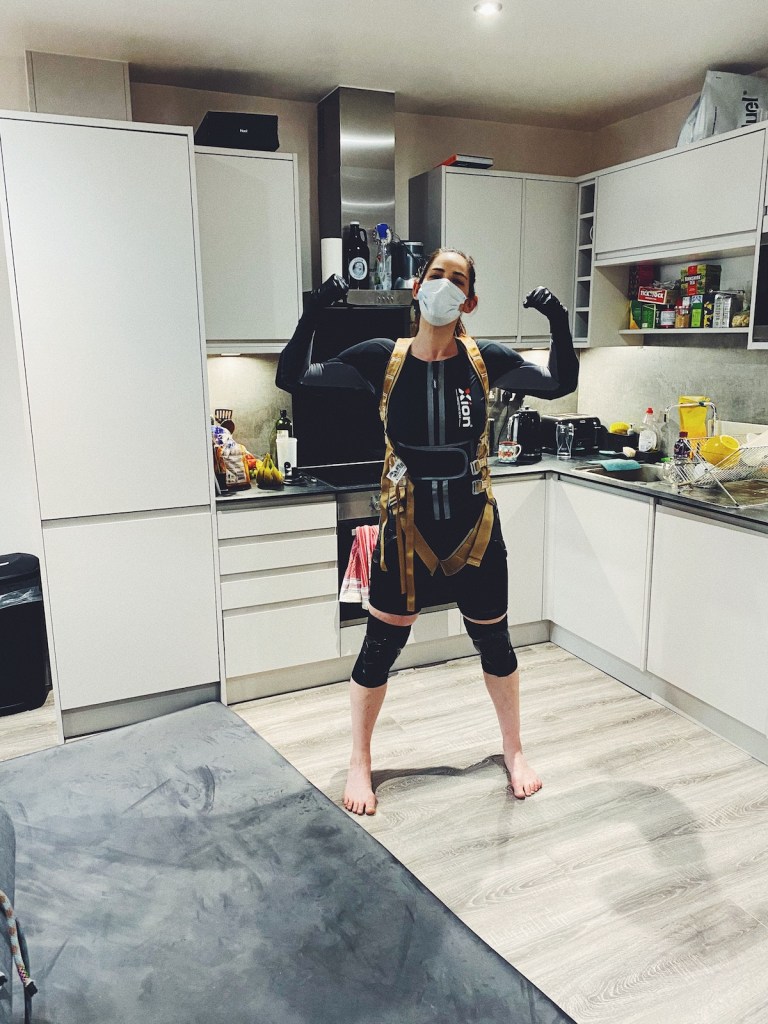
It’s microbudget but one of the things I loved about it is that it doesn’t look like that. I expected creepy things in the background but then towards the end, there’s actual proper stunt work, which is amazing. I’d like to hear a bit about the decision to do that?
RS: One of the reasons we wanted to go so big at the end is because we knew that people would have very low expectations going in. On paper, it sounds really shit, “Zoom, horror movie.” If I was to read that headline, I’d be like, “Fuck off.” And the fact that we made it under lockdown conditions, I think is always going to be at the forefront of people’s minds. One thing you’re always looking to do when you’re making a movie, especially a horror movie, is to make the audience feel that they’re without a roadmap, that they don’t know what the next turn is going to be. From the beginning, when we blocked it out, we separated it into three acts.
The first act was the seance. The second act was the haunting. And the third act was the freak out. We really wanted it to feel like by about half an hour in, the audience felt like they knew all our tricks. Then we wanted to show them something that was like, “No, you haven’t seen anything yet.” We really wanted to push that final act and make it a roller coaster.
How did you do those big stunt set pieces – how much VFX was used?
RS: With the stunts there’s obviously VFX clean up and stuff, but it’s all pretty much what you see is what we did. So Teddy really got his face set on fire. Jinny really got picked up in the air and thrown into the swimming pool. Everything is 95% done in-camera with a little VFX cleanup to help it out. We started out by writing a list of all the cool things that we could do because of the people we know, the friends that we’ve worked with in the industry.
We had this amazing moment at the very beginning of the process where we were talking about the fact that we have to shoot it remotely as being this big, negative that we are having to constantly fight against. And then, we had this revelatory moment where we’re like, “Oh, but actually it means that we can work with anyone because anyone who’s got an internet connection can suddenly be on our crew.” So we wrote a big list of people who we knew who were just sitting around twiddling their thumbs. We had pyrotechnic experts. There’s an amazing house full of stunt performers who live with a stunt coordinator, which means that legally, without breaking lockdown, we could do all these amazing stunts. Teddy, as well as being an amazing actor, is also a fully qualified stunt performer who’s done burn work before, so we could get him on board and we could set his face on fire.
It was really out of necessity that we came up with all these ideas. Then, we retrofitted the scare scenes to what we knew we could achieve.
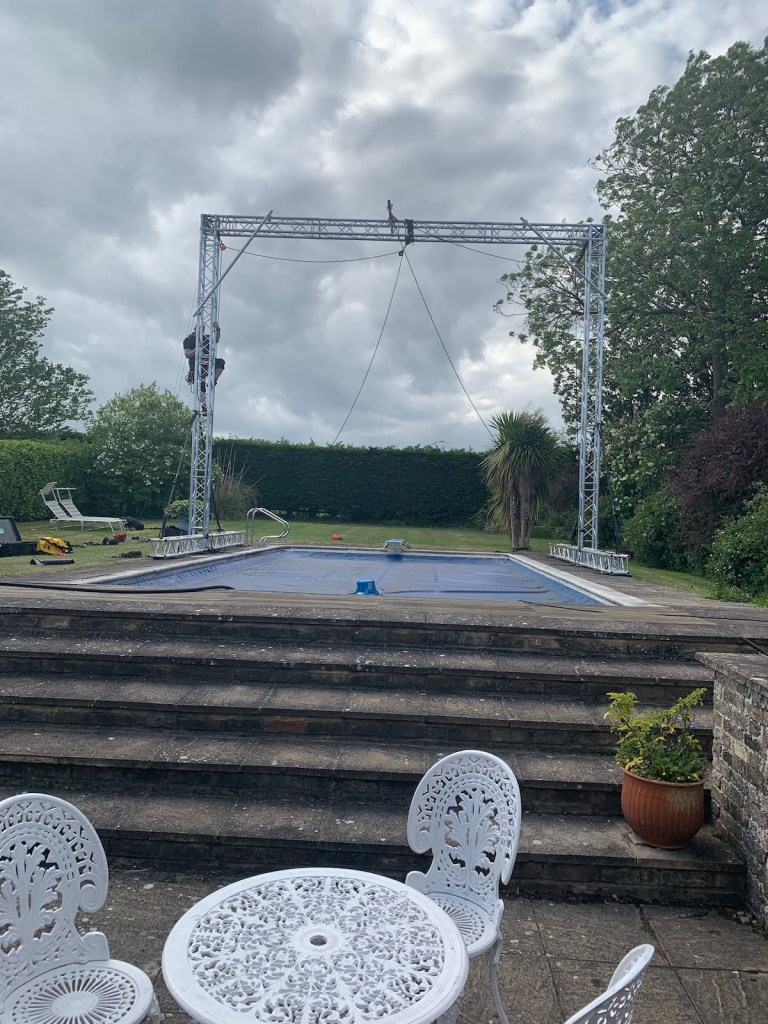
That’s brilliant. So the scene with Jinny over the pool, how did that work? How was she lifted?
RS: She’s on a wire, it picks her up. She chokes in midair and then there’s a remote control, like quick release, that lets her go, drops her into the water.
The picnic table at Emma’s death scene was obviously a real picnic table. It’s not a real Emma, though?
RS: Yes, that’s the same. That’s actually Jinny doing that fall. Jinny’s a qualified stunt person as well. We got those both on the same night, she went through a table and then she got hoisted in the air and dropped in a swimming pool. The way that we did that, it was actually the same system. So she was on a rope that dropped her down onto the table from this massive height and just stopped her. Just bungeed her a few inches off the ground. Even though she breaks the table which we loosened like in the old kung fu movies, we weakened it at all the important bits so it broke. She landed with that heavy kind of thump, but she didn’t actually go with all her weight and we didn’t actually break her neck.
That’s incredible.
RS: It was all done with the same rig on the same night. That bit of Emma’s garden is actually – if you were to pan the camera a meter over to the side, you’d see the swimming pool because we shot that in the same location.
James Swanton is your demon….
RS: Yeah. Yeah. Yeah. He filmed all those bits at his parents’ house.
I was wondering if he was ever in the same room as anyone…
RS: No, a lot of the stunts and the scares, it’s just hidden cuts. You go from Teddy’s house and he’s got the torch and the torch dips off-screen for a moment. So you’ve got a black screen and then the torch comes up and suddenly you’re in James Swanton’s house and it’s his mum shooting as he walks up the stairs and we see his face jumping out between the banisters. So it’s all just really lo-fi, little techniques like that. One of the biggest effects moments I guess is the moment where you see James, the demon, underneath Teddy’s pool table because we actually shot that against a green screen in James’s house and added him in to Teddy’s pool table. I think there’s the most VFX going on in that shot. The rest of them are pretty much all done in location.
You also worked with Dan Martin on prosthetics, but remotely, how did that work?
RS: He was great. I’ve worked with Dan a bunch of times and he was one of the first people on our list of awesome people who could probably do something cool for us. I messaged him and we figured that the best way probably was to send little prosthetic pieces to Caroline along with a kind of tutorial video, that Dan very kindly made, explaining how to attach it. So Caroline had a few test pieces that she applied first using this video. Then she had the real pieces that she applied on the day. So Dan basically just came on a Zoom call and took her through inch by inch how to apply the makeup, how to blend it in, how much blood to apply, where to apply it.
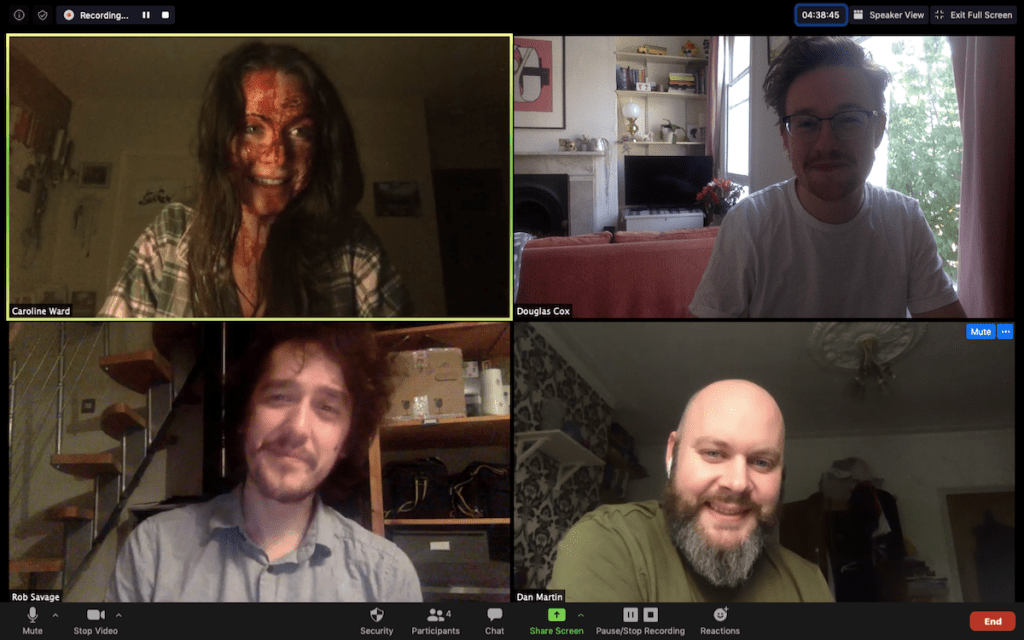
We had Caroline with a little cushion just out of sight so she didn’t completely brain herself on the laptop. She’d start with a little bit of blood running from her nose and she’d wack her head a couple of times. Then Dan would say, “Great, let’s do a broken nose now.” Then we’d add a little bit, and we’d crack her nose. Then she’d slam a couple more times and slowly we’d build it up until her face was all torn to shreds. Caroline was loving it. All the blood is basically corn syrup. So she was high as a kite by the end of it.
The whole Zoom background is brilliant because it does work like that, of course. You’ll come in and out of shot depending on where you’re sitting.
RS: Yeah. It’s a distance thing. That was one of the first scares we came up with that we wanted somebody to fly through the kind of threshold of the fake Zoom background. Again, that was just her. We set up her camera on her bed, covered her face in blood, and just had her “Superman” at the camera a bunch of times. Then, we stitched it together in VFX.
There are lots of moments and Easter eggs and things off-screen that people have alluded to. And certainly, I think I’ve seen you or possibly Jed [Shepard] allude to something that happens in the first three minutes?
RS: Yeah. So there’s something, I don’t want to spoil it totally… You should be looking around the moment where Jemma first joins, there’s a little… it’s less of a scare, it’s not a demon sighting or anything like that, but it’s a little clue as to what’s really going on. Yeah, that’s what I’ll say.
Post-seance, there’re a lot of moments where we’ve got scary things happening in the background or the demon lurking, which is little-blink-and-you’ll-miss-it moments where James will pop up. But really the first half, we basically give the audience everything they need to decipher what happens next. In the first five minutes, there’s clues to where the demon comes from, how everyone’s going to die, how the demon’s going to get summoned. Every single time we introduce a character, they’ve got a little clue as to what their fate’s going to be.
One of the big questions is about Seylan and what actually happens to her. There’s a key moment where something comes out of the corner just before she is cut off – to me it looks like something jumping out but it’s a very quick moment. What should we take from this?
RS: The idea is, it’s something bursting out. It’s something bursting out and knocking things flying in that moment. I know what I think when I’m watching it, but there’s no real right answer. In one take I got her to play it one way, and in another take I got her to play it another. But this idea of whether it’s actually Seylan who’s on the phone when they call… Our Terminator 2 moment.
What’s on the screen is a mixture of those two different takes. One where I got it to play it very much from the point of view of she has become the host of something and she’s possessed by something and she’s giving them the wrong information – because if you look at it, it’s only after they reengage with the spirit in the house, and they ask for further communication, that the shit really starts going down and they to get picked off. So Seylan doesn’t really do a whole heap of good there, which there’s a reading of that she’s helping the demon along.
Was the ambiguity important to you?
RS: With a lot of this, the creepiness is in the not knowing. It’s not like we filmed it and had a definitive answer in mind, but we filmed it knowing that we wanted to create a sense of ambiguity there because that’s what keeps you up at night.
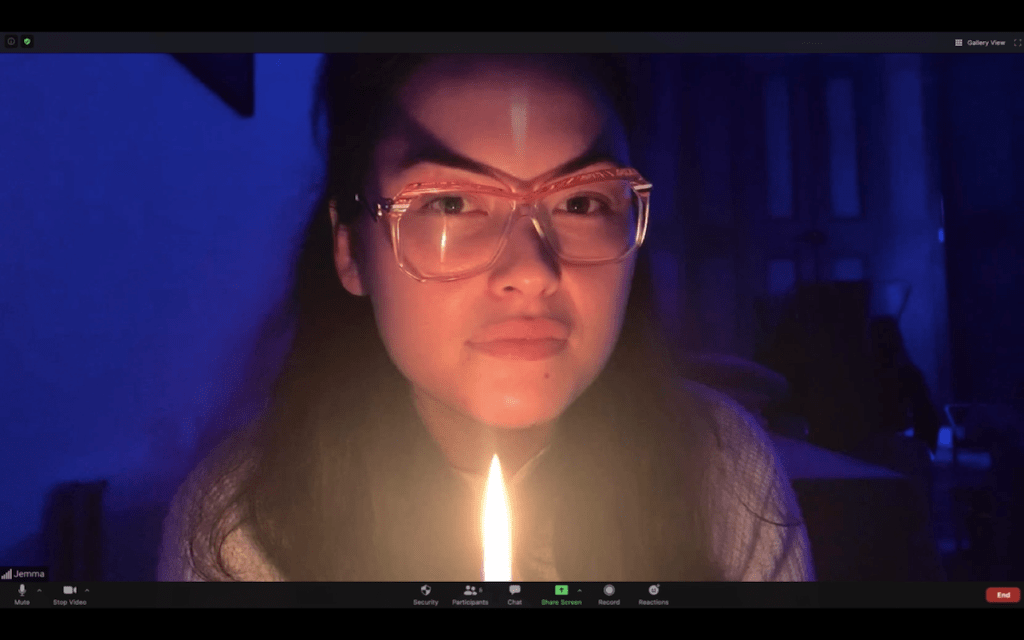
Jemma’s story, although she says it’s not true is weirdly specific. And then there’s all this hanging iconography, Jinny’s neck, and the noose in Teddy’s place…
RS: Exactly. When me and Jemma were working on how that scene would go, she actually made the decision to base the memory on somebody from her real life, who is still alive, but that’s why there’s that kind of weird specificity to it. And I mean, the way that we always thought about it is that it’s a ‘tulpa’ movie.
A tulpa is a ghost or a demon that is summoned by groupthink. So the idea is that if you’re all imagining the same person in your mind, they can manifest, even though they were never really alive and they were never really dead. The idea is that Jemma, by creating so vividly this person, that all of the group see in their head while they’re in this kind of weirdly connected state, allows the demon to come through and the demon starts to manifest using these images that Jemma has evoked. It’s kind of the demon’s way of mocking them or kind of toying with them. As the movie goes through, you start to see more and more of the demon in its real form. It becomes less Jack and more demonic. And then, the final shot, you see frames of a transformation happening where the recognizable figure of Jack starts to turn into something a bit more uncanny and demonic.
So in that sense, when Seylan explains the rules and she talks about how it’s a mask then everybody sees it and thinks of it in that way. And then, of course, we have mask iconography.
RS: Yeah. It’s all about that idea of groupthink. They’re in a collective nightmare by that point. The more that they lean into that, the more it starts to manifest.
Was that consciously a reference point or an allegory for what’s going on in the world?
RS: No, not really. We were really keen to not make it a pandemic movie. It’s a lockdown movie, not a pandemic movie. It’s really about the specifics of being isolated and going stir-crazy and the appearance of being connected, but actually being isolated. That was the main thing we wanted to tap into is it can feel like you’re hanging out in a group and your friends are there, but ultimately you’re on your own. And that’s the horror that we wanted to play out when things start happening, they’re all going through their own individual nightmares and everyone else is just a passenger.
The girls were friends already, right?
RS: We’re all just really good friends. They’re the same people who are in the initial prank video that I did. We were pretty much just hanging out on Zoom anyway, doing Zoom happy hours. And we just basically started pressing record and went from there.
There’s so much brilliant character development done without exposition, which is just really clever. How tightly scripted was it, and how much were they allowed to play?
RS: We gave them parameters for those early scenes. But there was never a conventional script. We had a 10-page outline with certain beats that they needed to hit. I spoke to all the different actors individually and talked about what they might want to bring to the table. I gave them sample lines of dialog that they could play around with, but we never did a full scripted rehearsal.
A lot of the actors didn’t know certain topics that were going to get brought up. It was more just prompts that I knew would be fun. So like the astral plane drinking game, that’s a line in the outline, but I didn’t know how they’d implement that and I didn’t tell Seylan that they were going to start drinking on the word astral plane. So the way that it came up felt kind of very natural and the way that the girls all kind of eyeball each other whenever the word is said is really fun. That’s all just happening for real.
You have mentioned that at points you’re referencing and homaging other movies – obviously there’s quite a bit of Paranormal Activity, what else can we look out for?
RS: Yeah. There’s a lot of Paranormal Activity, and I’m a big found footage guy and I love Paranormal Activity and all of those. Even though we made this in quite a condensed time period, there’s actually a lot more time you get to spend on these kinds of things when you’re filming remotely because you’re not waiting around for the lights to be set up or hair and makeup or any of these things. It means you can really tinker and you can put in these kinds of Easter eggy things, which we had a lot of fun with. I mean, there’s some really big obvious homages, like the final scene with the camera flash is on one end of the scale, we’re referencing the first Saw movie. On a slightly more highbrow end of the scale, we’re referencing Wait Until Dark, which is a movie we love.
The bit with Emma throwing the sheet over the ghost is us giving a nod – it’s sort of the first Conjuring movie, but that wasn’t actually what we had in mind. It was this movie called Satan’s Slaves, which is great. It’s on Shudder. It’s an Indonesian horror movie by this filmmaker, Joko Anwar. It’s really scary. He’s basically the next James Wan. And there’s a great fucking scare with a bed sheet, we were homaging that. Another movie that I love that I wanted to get a reference in for was Alice, Sweet Alice, which is a slasher movie from the ’70s. The mask that floats on the dispossessed demon is a direct reference to Alice, Sweet Alice. The participant ID is the date that Ghostwatch was released, which is a big reference.

Then, the password is DMK, which is from the movie Night of the Comet, which is a movie we love as well. Lake Mungo is a big one that we referenced. The Polaroid picture with the glimpse of Jack was a reference… or not reference, but just we wanted to kind of evoke that same creepiness of that kind of fuzzy, am I seeing what I think I’m seeing, kind of quality that Lake Mungo evokes.
So the obvious question is what’s next? What can we be looking out for? Are you likely to make anything else in lockdown?
RS: Oh, yeah definitely. Because of the success of Host, there’s been a huge interest in doing more. We’ve got lots of ideas that I don’t think people are going to quite expect. The last thing we want to do is try and just repeat Host because it’s such a specific thing, and we did it without any intention of it blowing up like this. So I think if we came at it now with all this expectation, I think it would probably just suck. So we’ve got a really fucking cool follow-up that we want to do that’s in a similar space. That’s going to really take people by surprise.
If Shudder wants us to, we’ve got plenty more of these ideas. And I want to keep making stuff until the world reopens again. It’s so much fun being able to make it… It’s a much more creative process than doing the normal film or TV series, doing it this way in such a condensed time. You can spend years and years developing something that never goes anywhere, but to have a movie conceived and out there in 12 weeks is a dream. So I’d love to do more of them.
Host is available to watch on Shudder now.
